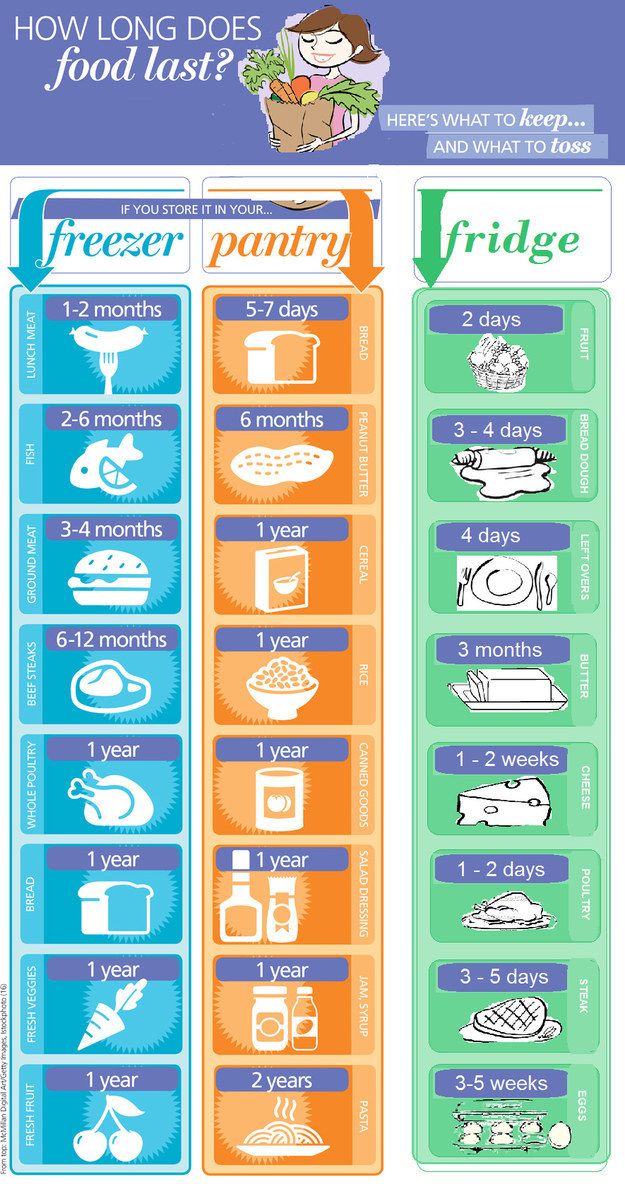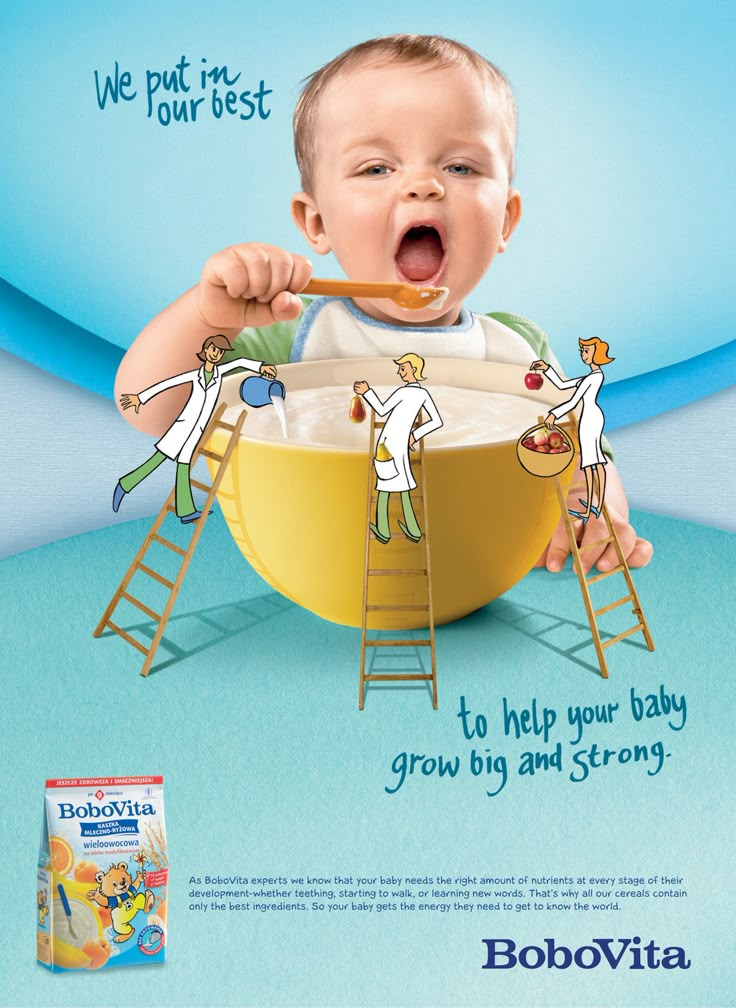Safe finger foods for babies
Best Finger Foods for Babies: The Ultimate Guide
How exciting that your baby is about to graduate from mushy foods to finger foods! This is a big step in your little one’s development. However, you may be wondering when’s the right time to start finger foods, and how to tell that your baby is ready. We’ll answer all these questions and more, plus give you a list of the best finger foods to introduce to your baby first.
Introducing Finger Foods to Your Baby
So, when can babies eat finger foods? You can start to give your baby finger foods around the time they’re able to sit up independently and can bring their hands to their mouth. This may happen between the ages of 8 months old and 9 months old, but your baby may be ready a little sooner or later than this time.
Around this time, you may also notice that your baby is developing their pincer grasp and may be making chewing motions. These are both great indications that your baby’s ready for finger foods. Moreover, using their fingers to pick up foods will further develop your baby’s fine motor skills.
Some parents who adopt the baby-led weaning approach may start offering finger foods to their infants as early as 6 months old. This method skips spoon-feeding with solid foods and instead lets your baby take the lead in self-feeding with finger foods. Some believe this approach can decrease fussiness when it comes to introducing new foods, including finger foods, to your baby. Speak to your child’s healthcare provider if this method is something you’d like to try.
Giving your baby finger foods can help your little one learn to feed themself, just one step toward gaining independence. Self-feeding can be great fun for your baby. Even if much of the food doesn’t end up in your baby’s mouth, the fact that they’re exploring this new frontier is an accomplishment to be proud of.
First Finger Foods for Your Baby
As you begin choosing finger foods for your baby, check out the following ideas:
Steamed veggies like sweet potatoes, potatoes, carrots, green beans, peas
Soft, ripe fruits like bananas, berries, peaches (peeled), mangoes (peeled)
Whole-grain breakfast cereals (without nuts, clusters, or chunks)
Whole-grain pasta (cooked well)
Whole-wheat bread
Whole-grain crackers or wafers like teething biscuits
Soft meats like chicken
Cheese (mild)
Scrambled eggs.
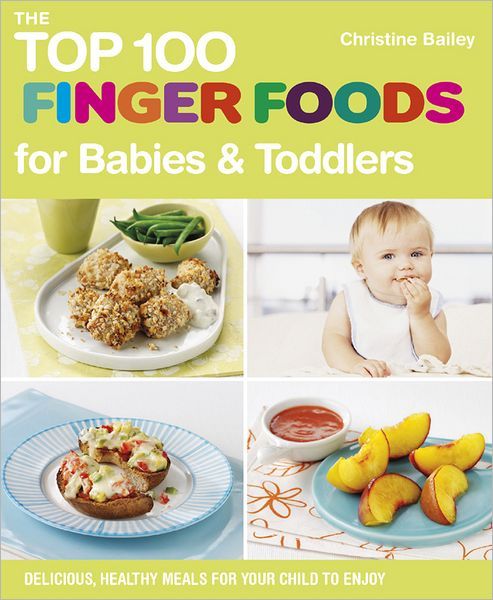
Be sure that any of the above finger foods are cut into small pieces. You don’t want your baby eating a piece that’s too big to swallow. And, make sure to watch them while eating.
Finger Food Safety
During this time babies are more likely to swallow foods without chewing them, whether they have a few baby teeth coming in or they have no teeth. Avoid giving any finger foods that require a grinding action to chew (this type of chewing is typically mastered around the age of 4), as these may pose a choking risk. Offer finger foods that are soft, easy to swallow, and broken or cut into pieces that your baby cannot choke on. A good rule of thumb is that soft and mushy finger foods are safe for your baby. Small, round, coin-shaped, hard, chewy, crunchy, slippery, or sticky foods may lead to choking. Here are some foods to avoid offering your baby when they start on finger foods:
Peanut butter (in chunks)
Meat (in chunks)
Cheese (in chunks)
Raw veggies (in large chunks or round shapes), including celery sticks, carrot sticks, baby carrots, cherry tomatoes, and peas
Raw hard fruit (in large chunks or round shapes), including apples, pears, and grapes
Nuts (whole)
Seeds
Popcorn
Chewing gum
Candies (hard, gooey, or sticky)
Hot dogs or meat sticks.

There are ways you can still give some of the above foods while making them easier to eat and less hazardous to swallow. For example:
Grapes or cherry tomatoes, cut in half
Creamy peanut butter spread thinly on whole-grain bread that’s cut into small squares
Hot dog, cut lengthwise and then cut into small 1/2-inch pieces.
Note on Food Allergies
Medical experts once recommended that parents avoid feeding their babies eggs, fish, and peanut butter since babies may be allergic to these foods. However, it’s now recommended that you introduce these foods early—while keeping a close watch for any reactions—since this approach can help reduce your child’s chances of developing food allergies. Before introducing peanut butter or peanut products, consult with your baby’s healthcare provider. Your baby is more likely to be allergic to these foods if
food allergies run in your family
your baby is known to have an egg allergy
your baby has eczema.

The Bottom Line
It’s time to introduce finger foods to your baby when you see that they’re able to sit up on their own, start bringing their hands to their mouth, and can use a pincer grasp to hold onto small items, like finger foods. This development happens around the age of 8 or 9 months old, but you may see it sooner or later in your baby.
In the beginning, you’ll want to introduce finger foods that are soft and easy to swallow, since babies at this age tend to swallow instead of chew even if they have a few baby teeth. Think steamed veggies and soft fresh fruits. You can also introduce whole-grain bread, crackers, cereal, or pasta if they’re cut into small pieces. Chicken, mild cheese, and scrambled eggs are also great options when served in small pieces.
Avoid hard foods like raw veggies and fruits, as well as chunks of nut butter, cheese, and meat. Whole nuts and seeds are not recommended, nor are chewing gum, candies, hot dogs, or meat sticks. All these items can pose a choking hazard.
All these items can pose a choking hazard.
Transitioning to finger foods is a big step in your baby’s development and independence. Letting your baby self-feed with finger foods may be a bit messy at first, but you’ll both get the hang of it. Learn more about developmental milestones for your 9-month-old baby.
Best Early Finger Foods for Baby (With Tips, Visuals, and Recipes)
Use this list of safe, nutritious, and easy to eat finger foods for baby to help you know exactly what (and how) to offer at meals and snacks. Plus, find the best first finger foods, troubleshooting tips, and visuals of foods broken down by food group to keep things easy!
Finger Foods for Baby
After baby starts solids and is ready to move onto finger foods, you may feel a little confused by exactly what to serve and how to serve it. Which is totally normal because it can be scary to let baby feed themselves this way and we may not have any experience doing this—or we may have totally forgotten from our last kiddo!
This list of finger foods for baby will cover some great first finger foods to start with, then set you up with plenty of healthy options from each food group.
TIP: Find more info on starting solids here and the best foods to start with if doing baby led weaning or purees with baby.
Healthy Baby Food
I love sharing these ideas for baby food since they are easy to prepare and serve and because I know how hard it can be to continue to come up with flavorful and healthy meals and snacks for our little ones. Let me tell you, I’m on my third kiddo and it can be such a challenge to feed him during the chaos of parenting the rest of my crew! These foods are wholesome and nutritious—perfect for your baby.
TIP: I’m a big fan of SpoonfulONE, a company that offers the most complete way to introduce food allergens to our kids. They make mix-ins, puffs, and crackers that are yummy and easy for babies and toddlers to eat. Learn more about their pediatrician-approved baby foods here. (sponsored link)
Best First Finger Foods
When baby is around 9 months, you’ll notice that they’re able to pick up smaller pieces of food with two fingers. This is known as the “pincer grasp” and is a sign that they’re ready to start finger foods. To be clear, when I say “finger foods” I mean small pieces of food that a baby (or toddler) can feed themselves.
This is known as the “pincer grasp” and is a sign that they’re ready to start finger foods. To be clear, when I say “finger foods” I mean small pieces of food that a baby (or toddler) can feed themselves.
Here are some of my favorite ones to start with that are all super soft, safe to eat, and easy to pick up.
- Scrambled egg, broken up into small pieces
- Roasted sweet potato mashed and broken up into small pieces
- Fresh raspberries, broken up into smaller pieces
- Oatmeal, cooked according to package directions and allowed to cool
- Tofu, diced and sauteed lightly or steamed
- Ground beef, chicken, or turkey, broken up into small pieces or lightly mashed meatballs
- Shredded cheese or crumbled goat cheese
- Mashed sweet potato, in little pieces
- Peanut butter puffs
TIP: You can serve the tofu, ground meat, or meatballs in veggie puree from a pouch or a simple marinara sauce for extra moisture and flavor. Learn more about how and why to introduce peanut butter.
Learn more about how and why to introduce peanut butter.
Finger Foods for Baby: Fruits and Veggies
Some of my favorite early fruits and veggies to serve babies are:
- Mashed roasted sweet potato, broken up into small pieces
- Warmed frozen peas, slightly mashed if desired
- Roasted Zucchini
- Diced Roasted Sweet Potato or Butternut Squash
- Fresh blueberries, cut in half or quarters
- Fresh raspberries, broken into small pieces
- Banana, broken into small segments (they are less slippery this way versus slicing them)
- Avocado, diced and mashed slightly (be sure it’s ripe and very soft)
TIP: A good rule of thumb is to serve pieces of food that are about the size of a pea to start and soft enough that they are easy to squish between your fingers. This will be easy for baby to pick up and eat and will also reduce chances of choking.
Finger Food Ideas: Carbohydrates
Offering complex carbohydrates can provide fiber, a variety of textures, B vitamins, and more. Try these with your baby.
Try these with your baby.
- Spinach pancakes (moisten with applesauce or plain yogurt if needed; this recipe is particularly moist and great for babies)
- Oatmeal, cooked according to package directions and allowed to cool
- Baby Puffs
- Peanut Butter Puffs
- Rice (it’s easiest if it’s in little clumps so baby can pick it up; this Coconut Rice or this Cheesy Rice are both good options)
- Baby Banana Muffin
- O cereal (soften in nondairy unsweetened milk or yogurt as needed)
- Baked Oatmeal, diced
Finger Food Ideas: Proteins
Offering proteins will continue to expose baby to a range of nutrients. These are my go-tos for babies newer to finger foods—and toddlers too.
- Shredded cheese (thicker cuts are a little easier to pick up)
- Tofu, diced and sauteed lightly or steamed
- Flaked cooked wild salmon
- Lightly mashed meatballs
- Shredded chicken, cut up finely (we love this Butter Chicken to share with baby)
- Ground beef, turkey, or chicken, broken into smaller pieces
- Lightly mashed beans
- Scrambled eggs, broken up into small pieces
- Diced egg muffins
I’d love to hear any questions you may have, or if you have foods that your babies enjoy that I didn’t include here.
 Chime in below in the comments!
Chime in below in the comments!Prep Time 5 minutes
Cook Time 5 minutes
Total Time 10 minutes
Author Amy Palanjian
Cuisine American
Course Baby Food
Calories 124kcal
Servings 1
First Finger Foods (choose 1-3 per meal)
- ▢ 1 Scrambled egg (broken up into small pieces)
- ▢ 1/4 cup Roasted sweet potato, mashed and broken up into small pieces
- ▢ 1/4 cup Fresh raspberries (broken up into smaller pieces)
- ▢ 1/4 cup Oatmeal (cooked according to package directions and allowed to cool)
- ▢ 2 tbsp Tofu (diced and sauteed lightly or steamed)
- ▢ 2 tbsp ground beef, chicken, or turkey, broken up into small pieces or lightly mashed meatballs
- ▢ 2 tbsp shredded cheese or crumbled goat cheese
- ▢ 1/4 cup Mashed sweet potato (broken into little pieces)
- ▢ 1/4 cup Peanut butter puffs
Fruits and Veggies
- ▢ 1/4 cup mashed roasted sweet potato (broken up into small pieces)
- ▢ 1/4 cup warmed frozen peas
- ▢ 1/4 cup Roasted Zucchini
- ▢ 1/4 cup diced Roasted Sweet Potato or Butternut Squash
- ▢ 1/4 cup blueberries (cut in half or quarters)
- ▢ 1/4 cup raspberries (broken into small pieces)
- ▢ 1/4 cup banana slices (broken into small segments—they are less slippery this way versus slicing them)
- ▢ 2 tbsp avocado (diced and mashed slightly—be sure it's ripe and very soft)
Whole Grains and Carbohydrates
- ▢ 1 Spinach pancakes (moisten with applesauce or plain yogurt if needed; this recipe is particularly moist and great for babies)
- ▢ 1/4 cup Oatmeal (cooked according to package directions and allowed to cool)
- ▢ 1/4 cup Baby Puffs
- ▢ 1/4 cup Peanut Butter Puffs
- ▢ 1/4 cup fully cooked rice (it's easiest if it's in little clumps so baby can pick it up; this Coconut Rice or this Cheesy Rice are both good options)
- ▢ 1 Baby Banana Muffin
- ▢ 1/4 cup O cereal (soften in nondairy unsweetened milk or yogurt as needed)
- ▢ 1/4 cup Baked Oatmeal (diced or regular oatmeal broken into little pieces)
Dairy
- ▢ 2 tbsp Shredded cheese (such as mozzarella)
- ▢ 2 tbsp Tofu (diced and sauteed lightly or steamed)
- ▢ 2 tbsp flaked cooked wild salmon
- ▢ 1 lightly mashed meatballs
- ▢ 2 tbsp finely shredded chicken (we love this Butter Chicken to share with baby)
- ▢ 2 tbsp ground beef, turkey, or chicken (broken into smaller pieces)
- ▢ 2 tbsp lightly mashed beans
- ▢ 1 Scrambled egg (broken up into small pieces)
- ▢ 1 Diced Egg muffins
For each meal or snack, choose 2-3 foods from a mix of food groups.
 Aim to include some fat in most meals and protein in many too.
Aim to include some fat in most meals and protein in many too.Prepare the food, cutting into small pieces and/or mashing as needed to make the food easy to eat.
Start with small portions and allow more as baby indicates according to their hunger.
- Store leftovers in an airtight container for 3-5 days in the fridge.
- Many foods you cook for your family will work as baby finger foods—just be sure they are easy to squish between your fingers and the pieces are small and easy to chew.
- Babies very normally make a lot of faces when they eat, so don't assume they don't like something just because they scrunch their nose!
- Flavors and textures can take time to learn to eat, so continue offering foods in small portions even if baby hasn't liked them in the past—and make sure they taste good to you!
Calories: 124kcal, Carbohydrates: 14g, Protein: 7g, Fat: 4g, Saturated Fat: 1g, Polyunsaturated Fat: 1g, Monounsaturated Fat: 2g, Trans Fat: 1g, Cholesterol: 164mg, Sodium: 81mg, Potassium: 344mg, Fiber: 4g, Sugar: 5g, Vitamin A: 9857IU, Vitamin C: 18mg, Calcium: 51mg, Iron: 1mg
Tried this recipe?Rate in the comments and tag @yummytoddlerfood on IG!
Dishes for a children's party / A selection of the most successful recipes - an article from the "What to feed" section on Food.
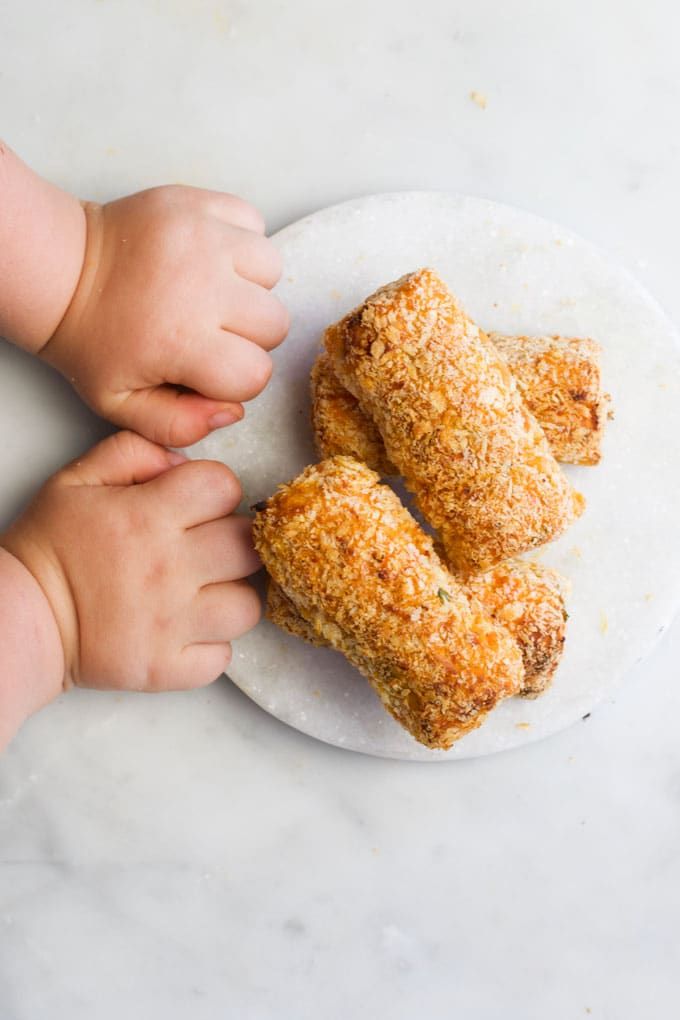 ru
ru 1. Pizza for a birthday
It is difficult to find children who do not like pizza. This versatile, simple and satisfying dish is great for a children's party. If you don’t have time, a decent pizza delivery, or you don’t want to mess with the dough, you can easily and quickly cook it on thin pita bread.
It is good to serve pieces already cut into triangles on the festive table, for convenience, place each piece in a beautiful paper bag. By the way, so the pita bread will not wind up yet.
You can use not only traditional pizza products as a filling:
For example, you can take:
-
marshmallows: they are perfectly baked in the oven;
-
fruits;
-
berry jam or jam.
Chocolate is suitable as a topping.
If you do not plan to extend the children's party for a long time, you can get by with two pizzas: serve one as an appetizer, the other for dessert.
2. Cheese rolls
Quick and easy to prepare. Rolls or rolls look elegant, do not fall apart and do not flow - ideal for a holiday.
Rolls or rolls look elegant, do not fall apart and do not flow - ideal for a holiday.
Put them on the table at the beginning of the party so that the hungriest of the children can fill up quickly.
You can vary the filling: for example, take not only cheese, but also sliced cucumbers or tomatoes, stewed or fried mushrooms. Older kids might like the birthday option with a cheese salad topping. And parents will be happy to try the dish when they leave or pick up the children.
3. Instead of french fries
Potato balls are an elegant alternative to boring french fries. This is one of the recipes that is suitable for an adult buffet table, and for a children's birthday.
If a full-fledged festive table is expected (snacks, hot and dessert), then tender mashed potatoes, deep-fried, will become a side dish for meat or fish. Or it can be a standalone dish.
By the way
To surprise and delight guests, you can make half the balls of cheese or curd mass: salty - with herbs and garlic, dessert - with raisins and condensed milk.
4. Unusual sandwiches
An adult snack that looks very appetizing. Very young ones may not like it: children are wary of unusual food combinations and unfamiliar textures. In this case, you can try making an appetizer with cheese or tomato instead of prunes. Replace the ketchup suggested in the recipe with a light sauce, for example, based on natural unsweetened yogurt.
If desired, the chicken can be substituted for the fish fillet: make sure the bones are removed. It is better to take sea fish, it is well suited for butchering.
5. Bananas in chocolate
Healthy, light and not too sweet dessert. It can be an alternative to the classic cake with cream or cream.
Chocolate can be replaced with carob-based topping, making the dish suitable even for very young guests. Or for those who prefer healthy sweets with a minimum of calories and sugar.
6. Sweet sausage
Instead of sausage cut into portions, candy can be made and cooled on bright corrugated paper substrates. Use colorful sprinkles to spruce up the tasty treat.
Use colorful sprinkles to spruce up the tasty treat.
Breakfast corn flakes are an alternative to corn sticks. Rice balls (colorful or chocolate), granola are also suitable. As a connecting mass, instead of toffee, you can take apple marshmallow, a paste of coconut flour and vegetable milk or condensed milk, ground dates or peanut butter in half with chocolate. Try several options - the children will surely be delighted.
7. Berry muffins
Muffins are similar in filling to a classic muffin or biscuit cake, but they do not need to be sliced. Depending on the size of the molds, they are great for both young guests and adults.
Strawberries and bananas are an easy option for a summer holiday. Strawberries, if desired, can be replaced with any other berries or fruits. Just find out if any of the guests are allergic to citrus fruits, for example. If this is not possible, take bananas, apples or pears - they usually do not have an allergic reaction.
8.
 Cake with cream
Cake with cream Dessert in cups or glasses, which is convenient to eat both sitting and standing. The banana in the recipe can be replaced with any nuts, grated chocolate, fruit pieces, fresh or frozen berries. You can add two or three food coloring to the dough for baking a biscuit, and then mix the multi-colored pieces in a glass. So the presentation will be more spectacular and festive.
If there are guests with gluten or dairy intolerances, please provide safe alternatives. Replace wheat flour with corn or coconut, rice or oat flour. Cottage cheese - tofu cheese, coconut cream or cream based on crushed nuts (cashews or coconuts).
9. Fruit on skewers
Simple fruit treat. You can invite the child to help in its preparation - so he will have a complete sense of involvement in the holiday. A very young assistant can be asked to put fruit on a skewer, an older cook can be entrusted with slicing apples, bananas and other fruits.
By the way, vegetable or cheese skewers can be assembled in the same way.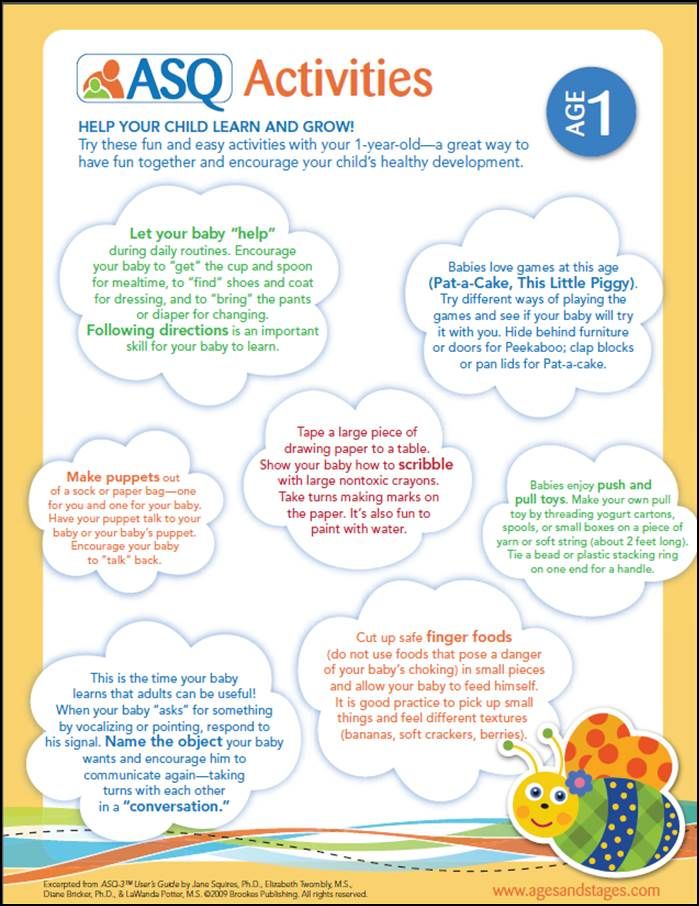
What can be done?
Prepare for the holiday, in addition to the main dishes, healthy drinks. Ask parents of younger guests if they can drink sodas or packaged juices.
But it's better to make homemade juice or compote. It will be much healthier and tastier.
Read also
-
The pediatrician explained how much sweets can be given to children without harm to health
-
How to cook with your children. Instructions for parents
-
Is it possible to give vegetable milk to children. And which one is better? After all, in addition to the all-encompassing joy, the preparation of the holiday is a huge job. You need to develop a concept, come up with contests and entertainment, take care of gifts and decorate the house. In a word, do everything to turn your birthday into a real fairy tale. In the list of preparatory events, the menu for a children's birthday stands apart. We have collected useful tips from many mothers so that after all the organizational and kitchen moments you have the strength and mood for the holiday itself.

Children's holiday menu : basic rulesExcitement before the holiday is a must. But it should be joyful, not shock in the spirit of “I don’t have time for anything.” Our rules are not strict imperatives, but they will help you relax and change your point of view on what is happening a little.
Rule 1. No frills
Let's be honest: on the birthday of a child, mothers try to please other mothers and their friends from social networks, who will definitely comment on photos from the holiday. That is why on the eve of the celebration on the Internet there is a search for intricate recipes. And now is the time to say “stop” to yourself. Regardless of age, children will be more likely to eat familiar dishes from familiar foods than, breaking their tongues, ask again: “Fricasé?” So ditch the cooking websites and write down the most common vegetables and fruits in the list - you can't go wrong.
Rule 2.
 Serve is key
Serve is key To encourage children to eat, the food must be colorful and interesting. From sausages - octopuses, from eggs and tomatoes - fly agaric, etc. Lay out salads with a snake with olive eyes or a hedgehog. Beautiful tubules and cocktail umbrellas in glasses. The younger the children, the more ideas you need to implement. At the same time, it is not at all necessary to complete carving courses - on the Internet you can pick up recipes for a children's birthday, which the most ordinary mother can handle.
Some dishes are best served in portions by purchasing tartlets for this purpose. Children are happy to eat canapes - they are attracted by their small size and bright skewers.
Rule 3. Healthy lifestyle forever
When compiling the menu, check with the mothers of invited children in advance about the presence of taste preferences and food allergies. But even without their tips, remember that food should not be too spicy, salty and fatty, it is better to refuse fried foods as much as possible.
 A moderate amount of chocolate and fruit, the absence of chips and soda will make the holiday both tasty and safe. For older children, the rules can be relaxed, but not completely abolished.
A moderate amount of chocolate and fruit, the absence of chips and soda will make the holiday both tasty and safe. For older children, the rules can be relaxed, but not completely abolished. Rule 4. Portions and timing
Children will not sit dignifiedly at the table for several hours discussing secular news. Therefore, all dishes for a children's birthday and salads need to be seasoned and applied little by little, the rest should be put in the refrigerator. Little guests will eat little and play pranks a lot - leave them time for this, taking your time to feed everything that you have prepared.
Rule 5. Chaos is inevitable
This rule is not exactly about the menu, but it is also important. Resign yourself to the idea that everything that pours will be spilled; everything that crumbles is scattered; everything that is smeared is smeared. And this is the more accurate, the younger the guests. Buy a beautiful, but inexpensive tablecloth in advance - and immediately mentally say goodbye to it.
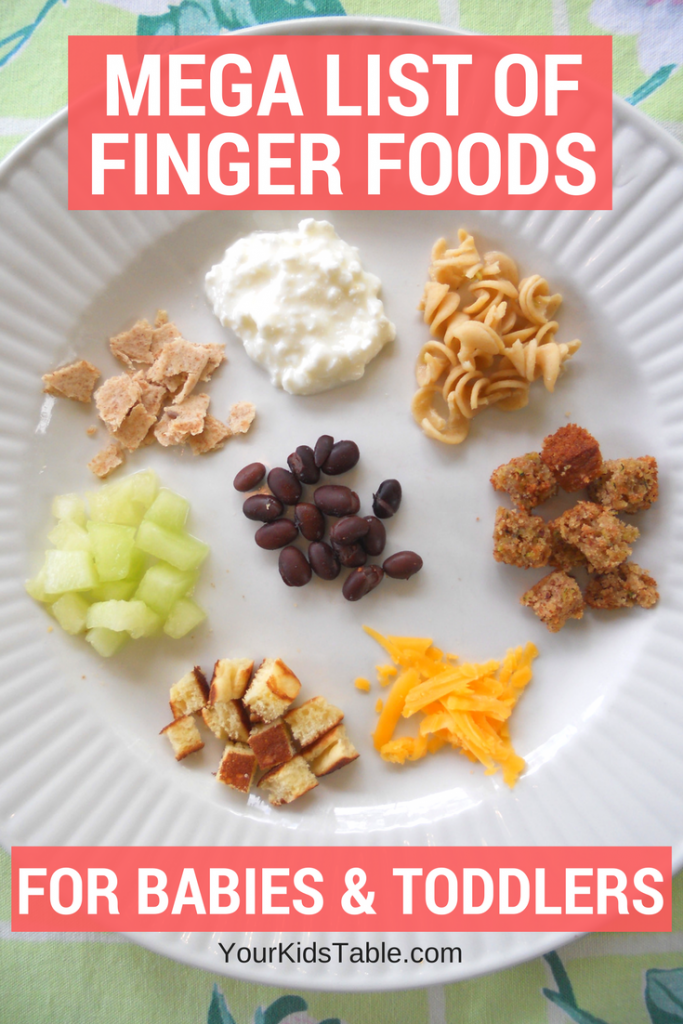
The same applies to the apartment. You can tap Mr. Proper on the batteries, or you can just get ready for cleaning - and give up on childish pranks. This is just for one day, tomorrow life will go back to normal.
What to cook for a children's birthday : popular and simple recipes with photosAs mentioned above, rabbit fricassee in wine sauce is not our option. In order not to rack your brains in vain, we offer the following children's menu:
- sandwiches,
- tartlets,
- canapes,
- hot dishes,
- meat,
- salad,
- sweet table,
- drinks.
SandwichesOriginally decorated, they are the perfect start to a festive feast. Take cheese, herbs, olives, sausage, some fresh butter and turn on your imagination. Thin toast bread is ideal for sandwiches. In general, it will be great if you have a special mold for cutting, for example, in the form of a heart or a circle.
 Then the toast can be given the desired shape.
Then the toast can be given the desired shape.
TartletsAn excellent a la carte dish that can be filled with homemade meat or fish pate, cottage cheese and fruit dessert and beautifully decorated.
CanapesChildren's birthday menu must include canapes - their kids eat with appetite. Combine ingredients of different colors, make fruit and vegetable sets, collect simple figurines to interest the little fussy. Assembling canapes is a rather monotonous process, and you need to make a lot of them, but you will be satisfied with the result.
Cherry tomatoes, olives, cheese, cucumbers and sausage create a bright and tasty combination.
Fruit variety - both beautiful and tasty.
HotOf course, children's birthday treats are not only small snacks, but also the main course.
 Usually children eat mashed potatoes, french fries well, but you can go further and cook potato mushrooms. To do this, the potatoes need to be boiled in their skins, cooled and shaped with a knife into a mushroom. After that, put on foil and bake in the oven until a delicious crust appears.
Usually children eat mashed potatoes, french fries well, but you can go further and cook potato mushrooms. To do this, the potatoes need to be boiled in their skins, cooled and shaped with a knife into a mushroom. After that, put on foil and bake in the oven until a delicious crust appears. For older children, “mushrooms” can be deep-fried, and then be sure to let them drain on a napkin.
Ketchup goes well with potatoes, you can buy special ketchup in the store without dyes and preservatives. Please note that it is not stored for a very long time, so do not purchase much ahead of time.
Another win-win option is homemade pizza. You can prepare the most common dough in just 30 minutes. As a filling, use boiled sausage, sausages, boiled meat, tomatoes, herbs, olives, cheese, canned corn.
MeatMeat can be served with the potato garnish. For children, it is better to use turkey, chicken or veal meat.
 You can cook cutlets or bake kebabs on skewers.
You can cook cutlets or bake kebabs on skewers. Meat for shish kebab should be marinated in sour cream with vegetable oil, salt and lemon juice in the evening. Add chopped onion (no need to bake, children rarely eat it, but it will help soften the meat). On the day of the celebration, the pieces are strung on special skewers and fried in a pan until golden brown. Then they are laid out on foil and baked until cooked.
SalatiWe emphasize once again that the dishes for a child's birthday should be simple and healthy, and therefore an ordinary vegetable salad seasoned with butter or sour cream will be an excellent option. Mayonnaise, ideally, should not be at all, but if anything, then cook it yourself literally for one dish. For example, lettuce "Carrot". For it, you need to boil turkey or chicken fillets, potatoes, eggs and carrots. Form a carrot and spread the meat, potatoes and egg in layers, brushing a little with mayonnaise.
 Sprinkle the top thickly with boiled carrots, press down the grooves with a toothpick, make a ponytail from a bunch of dill or parsley. Delicious and original salad is ready.
Sprinkle the top thickly with boiled carrots, press down the grooves with a toothpick, make a ponytail from a bunch of dill or parsley. Delicious and original salad is ready.
Sweet tableYou can bake on your own, or you can buy a beautiful cake and fresh pastries in a trusted pastry shop.
Be sure to put a fruit plate or basket on the table so that the children can take what they like, and a small bowl of sweets. Drinks Homemade compote, uzvar, juice or tea is the perfect solution. Usually children drink a lot, this should be taken into account when preparing drinks.
Nothing complicated, right? The list of dishes will vary depending on the age of the birthday person and taste preferences, but as a basis, it will come in handy for several years. Let the question “What to cook for children on their birthday?” no longer bothers you. Focus on the fact that N years ago you became a mother, feel this universal happiness again, and let the holiday really be a holiday for you.


